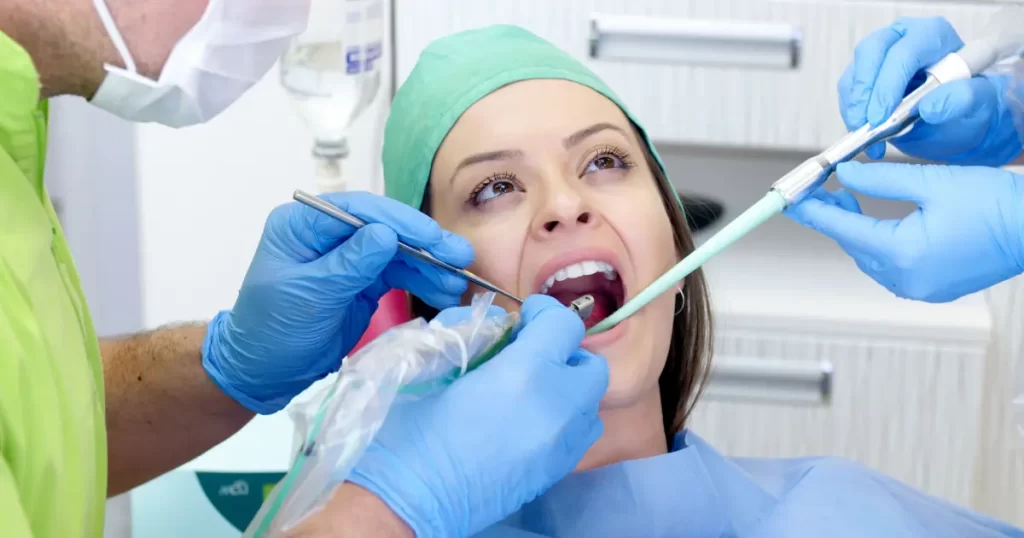Smile esthetic is about visual and psychological factors that perception of smile’s beauty. There are several ways in smile esthetics that uses to create an attractive smile.
What Is Esthetic Smile?
A beautiful smile is an essential component of a person’s appearance. It can affect how others perceive us and our self-confidence. Smile esthetics is a branch of dentistry that focuses on enhancing the look of a person’s teeth and gums. The ultimate goal of smile esthetics is to achieve a natural-looking smile. That complements a person’s facial features.
An esthetic smile is one that is symmetrical, proportional, and harmonious. It involves a balance between the size, shape, and color of the teeth, as well as the alignment of the jaw and gums. Aesthetically pleasing teeth are often referred to as “Hollywood smile” or “celebrity smile.”
Achieving an esthetic smile can involve a range of dental procedures. From simple teeth whitening to complex restorative treatments like orthodontics, veneers, or implants. These treatments can improve the look of crooked, chipped, or stained teeth. As well as correct misaligned bites, gum recession, or missing teeth.
What Are the Elements of Esthetic Dentistry?

The elements of esthetic dentistry include several factors. That affects the appearance of the teeth and gums. These elements are essential in creating an attractive and natural-looking smile.
- Tooth color: The color of the teeth plays a crucial role in smile esthetics. The ideal shade for teeth varies based on a person’s skin tone and age. Teeth can become discolored due to aging, smoking, or drinking coffee or red wine. Teeth whitening is a popular and effective method for improving the color of teeth.
- Tooth shape: The shape of the teeth is another important factor in smile esthetics. Teeth that are too small or too large can create an unbalanced appearance. Misshapen teeth can fix through dental bonding or veneers.
- Tooth alignment: Proper alignment of the teeth is important for function and aesthetics. Crooked or crowded teeth can fix through orthodontic treatment. Which can involve braces or clear aligners.
- Gum health and symmetry: The gums frame the teeth and are an essential component of an esthetic smile. Gums that are too high or too low can create an uneven appearance. Gum recession can fix through gum grafting. And excess gum tissue can be removed through gum contouring.
- Bite alignment: The alignment of the jaws affects the look of the smile and the function of the teeth. Bite problems like overbite, underbite can fix through orthodontic treatment or surgery.
Which Methods Are Used for Esthetic Smiles?
- Teeth whitening: Teeth whitening is a non-invasive and popular way to heal the color of teeth. It involves applying a bleaching agent to the teeth to remove stains and discoloration. Teeth whitening can do in the dental office or at home with custom-made trays.
- Dental bonding: Dental bonding is an affordable way to correct minor flaws for chips, cracks, or gaps in teeth. It involves applying a tooth-colored resin material to the affected tooth. Then shaping and polishing it to match the surrounding teeth.
- Veneers: Veneers are thin shells made of porcelain or composite material. They are custom-made to fit over the front surface of the teeth. Veneers can correct a range of flaws, including stains, missing teeth, and gaps. Veneers are a more invasive procedure than bonding but can provide long-lasting results.
- Orthodontic treatment: Orthodontic treatment involves the use of braces or clear aligners. It uses to straighten crooked or crowded teeth and correct bite problems. Braces are a more traditional method of orthodontic treatment. While clear aligners such as Invisalign are a more discreet option.
- Implants: Dental implants are a permanent solution for replacing missing teeth. An implant is a titanium post that is placed into the jawbone by surgical method. And a prosthetic tooth is then attached to the post. Implants provide a natural-looking and functional replacement for missing teeth.
- Gum contouring: Gum contouring is a cosmetic procedure. That involves removing excess gum tissue to create a more even gum line. This procedure can improve the appearance of gummy smiles or uneven gum lines.
- Gum grafting: Gum grafting is a procedure that involves taking tissue from one area of the mouth. And it transplants it to another area to correct gum recession. This procedure can improve the appearance of the teeth. It protects them from further damage.
- Full mouth reconstruction: This way is a comprehensive approach to restoring a smile. This procedure can involve a range of treatments. Like orthodontics, implants, veneers, and gum surgery to address many dental problems.
Which Teeth Are Most Important for Smile Esthetics?

- The central incisors are the most important teeth for smile esthetics. These teeth are the most visible when a person smiles. Their size, shape, and alignment are critical in creating an attractive smile. The central incisors should be symmetrical and proportionate to the surrounding teeth.
- The lateral incisors locate next to the central incisors. Those are important for smile esthetics. These teeth should be smaller than the central incisors. Also, it should complement their shape and alignment.
- The canines are the pointy teeth next to the lateral incisors. These teeth provide balance and symmetry to the smile. It should align with the central and lateral incisors.






